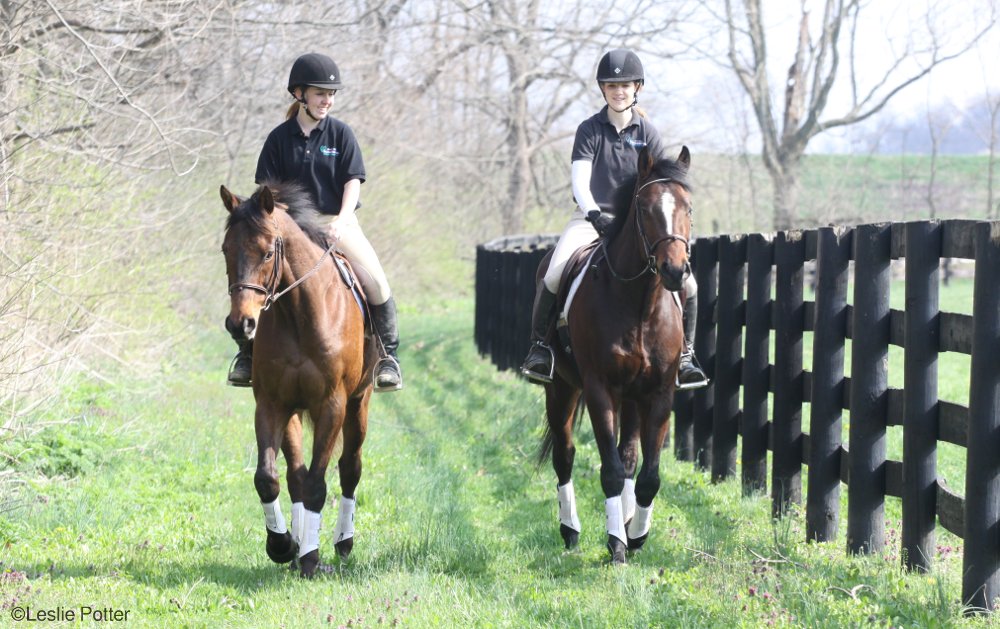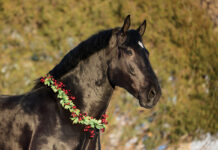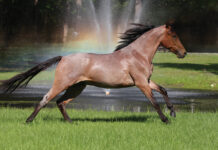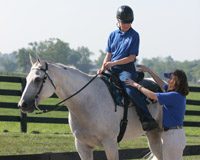
In the Company of Other Horses
“One of my biggest fears,” says adult amateur hunter rider Jill-Marie Jones of Yorba Linda, Calif., “was that my remarkably quiet ex-racehorse would morph into a cheetah as soon as I started cantering in a group of other horses. The first couple of times I hauled him to my trainer’s for a group lesson, I was very apprehensive. I was waiting for Topper and me to literally be off to the races when the whole lot of us cantered.”
Jill’s fears weren’t irrational. One of the vestiges of life at the racetrack is that the OTTB often perceives working in a group as another workout on the backstretch. If you’ve never visited a racetrack in the early morning hours, you’re missing orchestrated chaos. In one area, young or difficult horses might be schooling in and out of the starting gate. Other horses are being ponied at a restrained canter around the track. Some horses gallop individually. But there are also horses that are sent out to work with a stablemate. Then the two rivals link up and go head to head, matching stride for stride. It’s no wonder that when an OTTB first enters the realm of “civilian life,” he reacts to group activities much like he’s back at the racetrack.
 Before attempting to ride your OTTB in a group of horses, make certain that he is responsive to your aids. More than that, he should be predictable and dependable. In other words, you should be completely confident that when you say “whoa,” and apply the brakes, he’ll stop. The more attentive your horse is to your aids, the less likely he is to ignore you and improvise his best impression of Secretariat. Then, and only then, begin to ride with other horses. Be choosy. If possible, ask barnmates to ride their most sedate horses in the arena with you. Allow your OTTB to walk, trot and finally canter in the arena while the other horses stroll around at a slower gait. Quiet hacks on the trails, accompanied by a steady Eddie neighbor that can stand in as a lead pony, will help to decompress your OTTB, too.
Before attempting to ride your OTTB in a group of horses, make certain that he is responsive to your aids. More than that, he should be predictable and dependable. In other words, you should be completely confident that when you say “whoa,” and apply the brakes, he’ll stop. The more attentive your horse is to your aids, the less likely he is to ignore you and improvise his best impression of Secretariat. Then, and only then, begin to ride with other horses. Be choosy. If possible, ask barnmates to ride their most sedate horses in the arena with you. Allow your OTTB to walk, trot and finally canter in the arena while the other horses stroll around at a slower gait. Quiet hacks on the trails, accompanied by a steady Eddie neighbor that can stand in as a lead pony, will help to decompress your OTTB, too.
If your OTTB still seems on edge when he works in a group, add exercises that encourage him to focus on you and your demands, not on his surroundings or the other horses. For example, include flatwork movements like figure-eights and serpentines that not only develop suppleness in your OTTB, but also keep him from sightseeing. Does he elevate his head and become tense while working in a group? Try frequent transitions, but execute them slowly and deliberately. Vary his routine. Remind him of your previous lessons on remaining supple in his turns and circles. If you merely make continuous laps round and round your arena, he may begin to anticipate a cue to break into a gallop. Keep his intelligent mind intent on a task and he’ll begin to understand that other horses are not potential rivals.
One other mental adjustment your OTTB will have to make is accepting his new working hours. The average racehorse is stabled about 23 hours a day. During that one hour outside, he’s saddled, ridden to the exercise track at the walk, trotted a brief period to loosen up, and then he gallops a designated distance. Then he’s ridden back to the barn, untacked, washed off and put on the hotwalker. It’s a very predictable routine that is only altered slightly on race day. That’s why so many OTTBs initially have a short attention span. A weekly group lesson might seem like a marathon schooling session to your OTTB and is liable to elicit behavior like nervous energy or an evasion to your aids. Hence, keep your group activities to a minimum until your horse begins to understand that there’s a shift change involved with his new career.
Beginning to Jump: The Mind Matters Most
Beyond racing, one of the jobs most suited for the temperament and physical capabilities of the Thoroughbred is jumping. Whether it’s as a hunter, jumper or three-day event horse, the OTTB often finds a new career cantering over jumps rather than galloping down the homestretch. But introducing an ex-racehorse to the sport of jumping can be yet another challenge if you aren’t appreciative of your horse’s temperament.
At both the training farm and the racetrack, there isn’t much methodology to the Thoroughbred racehorse’s schooling. It’s pretty matter-of-fact: The young horse is bridled, saddled, mounted by a lightweight, agile rider, and then ponied out to an exercise track. Some farms are more attentive to the basics of breaking a young horse, but in general a horse aimed for the track isn’t taught the subtleties of learning a new skill in a step-by-step process. Hence, your OTTB may respond to his early jumping sessions by becoming frustrated and anxious. To the quick-thinking Thoroughbred, a mundane task like trotting ground poles or cavaletti seems like an annoyance. Yet you can’t rush the process or you’ll end up with a frazzled horse that sees jumping as yet another job to approach at a dead run.
When your horse is physically ready (consult a veterinarian), begin your introduction to jumping as you would with any green horse, with an assortment of easy trotting exercises over ground poles and cavaletti. Thankfully, most Thoroughbreds are inquisitive. They’re curious about new objects in their environment and brave enough to inspect them. In the beginning, the average OTTB will probably be suspicious of the obstacles in his path. But then he’ll make every attempt to decipher the puzzle and make a gallant effort to gingerly trot over without touching a single rail.
Signs that you’re proceeding too fast in your jumping instruction are a horse that begins getting quick before or after his jumps or one that raises his head to evade your half-halts on approach to the obstacle. In both instances, the ex-racehorse is finding solace in the one thing he knows how to do well: get leverage by leaning on the rider’s hands and running. As much as you may want to continue with jumping, you have to revisit your flatwork. Remind your horse about being supple to your hand and accepting of your leg. Bring him back to a good pace and rhythm by circling at the trot before heading down to the jump again. Or walk, pat him, and just hang out for a few minutes. You have to short-circuit any of your horse’s impulses to get quick and rush off. Don’t get discouraged if you find yourself spending weeks or months trotting single jumps or working through simple, low gymnastics.
At the opposite extreme are OTTBs that take to jumping with great flair, as if it’s a fun game. Their initial reaction to jumping may relate to how they perceived their job at the racetrack and the sort of early training they had as youngsters. Alpharetta, Ga., resident Denice Klinger remarked how her two OTTBs approached jumping. Although both horses went on to win numerous awards in the amateur adult and amateur owner hunter divisions, they took to their new careers with decidedly different attitudes.
“Robbie was very quick to learn. Within about 90 days of regular work he was like an old pro,” Klinger says. “He had a lot of natural balance, wasn’t terribly interested in racing and came from a farm that is known for putting good basics on their babies. It was the same farm that broke Smarty Jones.” By contrast, “Raven had been a very good racehorse. He liked his job at the track, and I think he figured he hadn’t signed up for a new job.” Raven took a good year before he accepted the idea of working on fairly light rein contact without revving up his engine and building his pace. “He was never a horse you took a serious hold on if you wanted to maintain any illusion of a pretty, relaxed hunter.”
From Racetrack to Show Ring
At some point you may work up the courage and determination to take your OTTB to a horse show. Before embarking on your adventure, consider how your ex-racehorse might perceive the horse show environment. What else might he think when a loudspeaker crackles repeatedly and unfamiliar horses trot and canter past, exuding competitive body language, than he is back at the racetrack? It’s best that you attend a few shows without any thought of actually competing to evaluate how he responds to the excitement.
“I spend a lot of time making sure that my OTTBs are ready for an over-stimulating atmosphere,” says hunter/jumper trainer Kristi Boyd of Trinity Hill Farm in Texas. She specializes in restarting off-the-track Thoroughbreds for the show-ring. Once she’s schooled her ex-racers to be confident on the flat at home, she hauls them to another site, even if it’s just another trainer’s place down the road. “They’re hauled out to a busier farm [so I can] see their reaction to crowds. I might spend a half-hour walking them in hand and then put them back on the trailer. Same thing once we move up to the shows. Most get on the trailer to go once or twice, and they may not ever leave the hay bag. I think it’s important to let each horse tell me when he is ready to accept more.”
While the horse may be working fine at home, even in group lessons, it might take him several dress rehearsals before he’s ready to perform onstage at an actual horse show. Many OTTBs acclimate right away to overnight stabling at a horse show—after all, chances are they have been hauled to a number of different racetracks—but some become over-stimulated within the show environment. You must be astute enough to ascertain what frazzles your OTTB’s brain, and then make efforts to desensitize him.
Boyd is remarkably observant as to what might trigger an anxiety attack in an OTTB. “I had a horse last year that could not cope with the sound system, so we went home and every night when I rode we brought the radio out. Eventually he learned to ignore the noises, and it made showing much easier for him.”
Cindy Hale is the author of Riding for the Blue and A Passion for Horses.
Further Reading
Retraining the Rescue Horse
OTTB Let Down Time and Nutrition






good article!
Great article! First time OTTB owners should read this. They have such high expectations from a horse that was trained differently from what the new owners want to do.
I am in the process of re-training my second OTTB, a gelding this time. The mare that I re-trained was an incredible hand-full but she ended up being a wonderful trail horse. It took me two years to do a good job of re-training her and I learned the hard way many of the suggestions that you make in your articles. Some OTTB’s do make good trail and pleasure horses, with the correct training. I spend months de-sensitizing them slowly to all the things they will encounter on the trail and the road. I also take them to shows for de-sensitizing. I just lead them around in hand, or ride them slowly where-ever I feel they will learn the most. The biggest problem that I have had with my new gelding is stomach ulcers and frequent gas colic, even without changes to his feed. It was merely the change in his routine that did it for him. I found that aloe vera juice twice a day for several weeks seemed to do the trick. I do not ride, or do much with my new OTTB for several weeks. I want their mind and body to heal. My guy is now out with my paint yearling and my 12 year old welsh, both geldings. He is mentally, more like the yearling. He is 4 years old, but plays and responds more like my baby. Time, patience and tons of understanding seem to be the key to these guys. I watch my guy very closely and let him tell me when he is ready for the next step. I sold my OTTB mare but this gelding is going to mine to keep. Alot of people think I am crazy for getting another OTTB because I am a 60 year old woman, but I love them. They are smart, loving and have more heart than we people deserve.
A very informative article, so many of the points explained are exactly how my daughters thoroughbred reacts. Having had lesson with an instructor didn’t accomplish much either…only told to get rid of the horse! His previous owner was a nervous rider who used a thin bit on him, basically to ‘control’ him, he’s also quite a sensitive horse, hence he wants to be close to you…not a good thing & is constantly being told to back away & be happy & safe in that spot, he has a lovely soft nature and tries hard to please. With this new found info we know have some ideas to put in to practice…thankyou
Absolutely true, all of it.